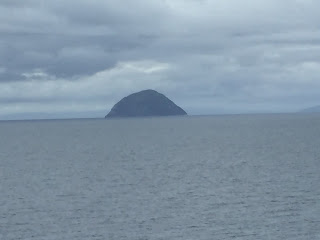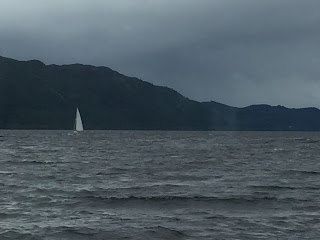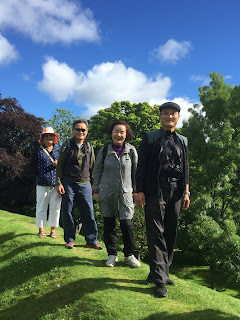Scotland became part of United Kingdom in 1603 when James VI, the kind of Scotland, was asked to be the king for England then already combined with Wales. When James VI of Scotland moved to England to be James I of England, Scotland and England became the United Kingdom of Great Britain. James I was the first king of Great Britain and reigned until 1625 when he died.
Scotland has a population of 5.3 million inhabitants. It is capital city is Edinburgh. Scotland has a land of 80,000 sq. km located at the northern part of the Island of Great Britain. Scotland is known for its mountain wilderness harmonized with glacial valleys and lochs (lakes), numerous castles and Loch Ness. Also, Scotland is famous for its whiskey "Scotch Whiskey" and is home of golf as represented by the 16th century Old Course at St. Andrews.
We took a ferry, European Causeway, from Port of Larne, Northern Ireland to arrive at Loch Ryan Port, Scotland after 2 1/2 hour sailing. We visited several places of interest in Scotland, experiencing the spirit of Scotland wherever we went.
Wallace Monument is symbolically important to the Scots. When you hear the word of "Spirit of Scotland" it pertains pretty much to the Scottish battle or struggle against England. That much, the Scots struggled for a long time against England.
Wallace Monument was erected to commemorate the victory of the Scottish peasant army in fighting against the well trained English army that outnumbered the Scottish commoners at a small bridge, the Bridge of Stirling, over a winding river. It is called the Battle of the Bridge of Stirling. The peasant army was led by William Wallace and his friend Andrew de Moray. This story was filmed in a movie "Brave Heart." Although the movie seems to have distorted the story somewhat, it depicts the Wallace story.
We climbed to the top of this monument through a very narrow stone staircase, but the view at the top was panoramic.
 |
| Adam Smith |
Calander: Kristin and I traveled through the U.K and Ireland with Expat Explore. In this tour, Mr. and Mrs. Jay Yoon and Mr. Jaesup Choi also joined. This became the fourth tour together with them after men climbing the Mt. Kilimanjaro together in 2011, five years ago. We also traveled together on a 3-week overland trucking from Cape Town, South Africa to Victoria Falls, Zimbabwe via Namibia and Botswana. Also, we traveled together on the Northern Explore exploring the Scandinavian and Baltic countries last year. It is always joyful to travel with them and it is a blessing to have such travel mates.
Before we began the Scottish Highlands driving tour, we stayed at a small town called Calander. There was a small river and the orange-colored scenery at the sunset reflected on the water was beautiful. With most of the shops closed, we strolled around the town peeping into the shops.
Highlands is the mountainous terrain in the western part of Scotland. The views were green and beautiful. They were not really comparable to the views we saw in the Alpine region, but nonetheless they were breathtaking.
We stopped over at several places to inhale the crisp air and to take photos. But it was virtually impossible to take the grandeur scenery into a photo, particularly with a cellphone. It is the limitation that I have to live with while traveling. Moreover, the mountains were foggy.
Loch Ness is well known for the unconfirmed monster called "Nessie" that has been reported to live in this deep Loch Ness. Loch Ness is so deep and long that all waters of Great Britain can be put into this loch and still there is room for more. The deepest part can contain a 75 story building and there is additional 5 feet space where you can maneuver. Inverness is the capital of Scottish Highlands. Inverness means the mouth of Ness. Indeed it is at the beginning part of the Loch Ness.
We took a cruise to the Urquart Castle that was strategically located by the lake with the backdrop of a steep mountain. The cruise was short and we failed to spot the monster, but it was good that we came to visit this place. We left the place with the legend or myth kept in darkness.
I took a selfie with a bagpiper in front of the cruise boat. He was accommodating.
Not too far from Loch Ness, there is one famous castle, called Eilean Donan Castle. I tried to make it over there while we stay in Edinburgh, but it was quite far and the road was too narrow and winding so I decided to skip it. Perhaps someday... Lord's willing...
Tomatin Scotch Whiskey ... Scotch Whiskey is world famous with main brands of Johnnie Walker and Chivas Regal all products of Scotland. We visited Tomatin Whiskey Distillery where we were explained about how they make the whiskey and how they are different from other whiskeys.
We learned that there is single malt whiskey and blended whiskey. Also, we learned that Scotch whiskey is fermented for 3 years while Bourbon for 2 years and Irish for 4 years.
The oldest casket that they are still using is from 1967. Wow... Well... what do I know about whiskey. But it was fun to look around the distillery facility. Also, there was whiskey tasting!
Edinburgh is the capital city of Scotland with a population of 500,000, but its metropolitan area houses 1.3 million inhabitants. Edinburgh is hilly and has a medieval Old Town and an elegant Georgian New Town with gardens and neoclassical buildings.
In Edinburgh, we stayed for two nights. On the first day, it was raining. Despite the rain, we walked around to hear the introduction to the city. We heard about Grassmarket where people were hanged and executed. We also heard about the poor people who were neglected that led to a story of "shit face" when drunken people looked up and got showered by the toilet dumps. Yikes....!
Edinburgh is famous for its iconic castle: Edinburgh Castle. It is home to Scotland's crown jewels and the Stone of Destiny, traditionally used in the coronation of Scottish rulers. It used to be the royal palace, but later used as the fortress or military facility. Currently it is used as the War Museum.
In front of the castle, they built a stadium where performances may be held. I thought the stadium was not going well with the old castle.
The distance from the Edinburgh Castle to the Hollyrood Palace is approximately one mile. So this route is called the Royal Mile. This route is filled with shops and historic buildings. We walked the Royal Mile and enjoyed the scenery, watching people, peeping into shops and visiting several places of interest.
 |
| St, Gile's Cathedral |
 |
| John Knox statue inside St. Gile's Cathedral |
 |
| Adam Smith |
 |
| Street Performers |
 |
| Torn Church turned into Royal Mile Market |
 |
| The Residence of Adam Smith |
We visited the National Gallery of Modern Arts and found interesting artworks on the front yard as well as inside the building.
We visited the Greyfriars Kirkyard, a church cemetery where the 1,200 Covenant People (Covenanters) were imprisoned, tortured and later executed. Despite this persecution, Presbyterians survived and thrived, now accounting for 30% of the 5 + million population. Kirk means church in Gaelic, the language that is spoken in Scotland, Ireland and Northern Ireland. Here at this Greyfriars Kirk, the National Covenant for Presbyterianism and the Ulster Covenant for Allegiance to supporting Protestants in Northern Ireland were signed.
There was a tombstone that showed the burial site for the Greyfriars Bobby, a Skye Terrier dog that guarded his owner's grave at Greyfriars Kirkyard for 14 years until he also died in 1872. We found a statue of this dog sitting on top of a fountain else where. How loyal the dog was!
We also visited a plaza on Grassmarket where criminals were executed in public. The very place where people were hanged is now a place of rest for weary tourists and locals.
Overall, we walked around quite a bit in the City of Edinburgh.
Spirit of Scotland Show was a show that showed the Scottish folk dancing and music. including the bagpiper, violin, guitar and accordion. We were welcomed by a bagpiper as we entered the Jam House.
Scottish haggis is a savory pudding containing sheep's pluck (heart, liver and lungs), minced with onion, oatmeal, suet, spices, and salt, mixed with stock, traditionally encased in the animal's stomach. Korea has a similar food called "Soondae." Anyway, I did not have the guts to try the haggis that was being passed around.
The dance was not impressive at all. Very simple and no sophisticated or beautiful movement. But, Amazing Grace played by the bagpiper was inspirational as always. The Kilts, dress-looking outfit that men are wearing are unique to Scotland along with the bagpipe. They wear the Kilts as a formal wear and they looked quite natural.
Historically, at least part of Scottish people have always wanted to be independent from the United Kingdom. So frequently a referendum has been presented for vote to break away from the U.K. Recently a year ago, this referendum was voted and defeated with a narrow margin of 49-51. But this year, Brexit was passed in the U.K again marginally while the majority of Scotland population wanted to stay with the EU. So the Scottish spirit started boiling again to break away from the U.K so that Scotland may remain in the E.U. Nobody knows what might happen, but I sensed a strong feeling of the Scottish wanting to be independent from the U.K. Well... Integration and disintegration... History repeats itself... - Jeffrey




















































































No comments:
Post a Comment